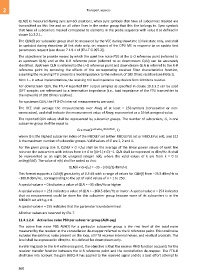Page 870 - 5G Basics - Core Network Aspects
P. 870
2 Transport aspects
QLN(f) is measured during sync symbol positions, when sync symbols that have all subcarriers masked are
transmitted on this line and on all other lines in the vector group that this line belongs to. Sync symbols
that have all subcarriers masked correspond to elements in the probe sequence with value 0 as defined in
clause 10.2.2.1.
The QLN(f) per subcarrier group shall be measured by the VCE during showtime L0 link state only, and shall
be updated during showtime L0 link state only, on request of the DPU ME in response to an update test
parameters request (see clause 7.1.9.1 of [ITU-T G.997.2]).
The objective is to provide means by which the quiet line noise PSD at the U-O reference point (referred to
as upstream QLN) and at the U-R reference point (referred to as downstream QLN) can be accurately
identified. Upstream QLN is referred to the U-O reference point and downstream QLN is referred to the U-R
reference point by removing the effects of the corresponding receiver filter characteristics function,
assuming the receiving FTU presents a load impedance to the network of 100 Ohms resistive (see Note 1).
NOTE 1 – In actual implementations, the receiving FTU load impedance may deviate from 100 Ohms resistive.
For downstream QLN, the FTU-R reported DFT output samples as specified in clause 10.3.3.2 can be used
(DFT samples are referenced to a termination impedance (i.e,. load impedance of the FTU transmitter to
the network) of 100 Ohms resistive).
For upstream QLN, the FTU-O's internal measurements are used.
The VCE shall average the measurements over Navg of at least = 256 symbols (consecutive or non-
consecutive), and shall indicate the measurement value of Navg, represented as a 16-bit unsigned value.
The reported QLN values shall be represented by subcarrier groups. The number of subcarriers, G, in one
subcarrier group shall be equal to:
G ≤ max(2 ceiling(log ((Θ+1)/512)) , 1)
2
where Θ is the highest subcarrier index of the MEDLEY set (either MEDLEYds set or MEDLEYus set), and 512
is the maximum number of subcarrier groups. Valid values of G are 1, 2 and 4.
For the given group size G, QLN(k × G × fSC) shall be the average of the linear power values of quiet line
noise on the subcarriers with indices from k × G to ((k+1) × G) –1. QLN shall be expressed in dBm/Hz. It shall
be represented as an eight-bit unsigned integer n(k), where the valid values of k are from k = 0 to
ceiling(Θ/G). The value of n(k) shall be coded so that:
QLN(k × G ×fSC) = −35 − (n(k)/2) dBm/Hz.
This format supports a QLN(f) granularity of 0.5 dB with a range of values for QLN(f) from −35.5 dBm/Hz to
−160.0 dBm/Hz , corresponding to the set of valid values of n = 1 to 250.
A special value n = 0 indicates a value of QLN = –35 dBm/Hz or higher
A special value n = 251 indicates a value of QLN = –160.5 dBm/Hz or lower. A special value n = 254 indicates
that no measurement could be done for this subcarrier group because none of its subcarriers is in the
MEDLEY set with gi > 0.
A special value n = 255 indicates that the parameter is undetermined.
All other values are reserved by ITU-T.
11.4.1.2.4 Active line noise PSD per subcarrier group (ALN-psg)
The active line noise PSD ALN(f) for a particular subcarrier group is the rms level of the total noise
measured by the receiver at the constellation de-mapper referred to the U reference point. This total noise
includes the extrinsic noise present on the loop, all FTU receiver internal noises, and residual crosstalk. The
level shall be expressed in dBm/Hz. It is defined for downstream only.
In referring back to the U-R reference point, the objective is that the receive PMD function accounts for the
receiver transfer function between the U-R reference point and the constellation de-mapper. The FTU-R
shall take into account the gain (AGC) it has applied to the received signal and do a best effort attempt to
860

